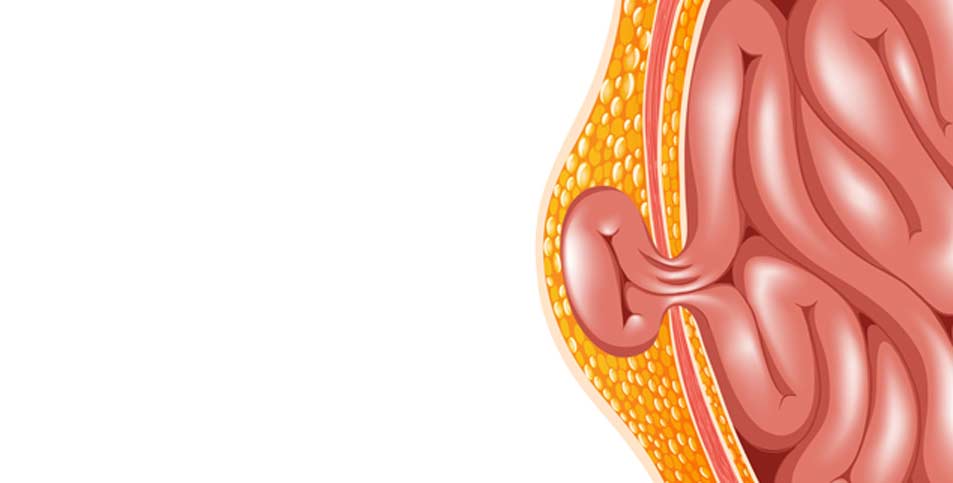
An umbilical hernia is a common health problem that occurs when part of the intestine sticks through an opening in the abdominal muscles.
While a baby is still in the womb, the umbilical cord passes through this opening to connect the baby to the mother. If the abdominal wall doesn’t close properly after birth, other tissue can poke through, causing a hernia. Umbilical hernias most commonly affect infants, and they usually close on their own within the first few years of life.
About one in five babies have an umbilical hernia when they’re born. Umbilical hernias that form during adulthood are less likely to go away on their own and may require surgical treatment.
Umbilical Hernia Symptoms
The most common sign of an umbilical hernia is a swelling or bulge near the navel. However, for many babies, the swelling is only visible when they cough, cry, laugh, or strain. Umbilical hernias in infants are usually painless, so you may not even notice if your baby has one. Pain and discomfort are more common with adult umbilical hernias. You may notice a bulge in your abdominal area as well as pain or pressure around your navel. In rare cases, an umbilical hernia can cause a lack of blood flow to the intestine, which can cause vomiting, fever, constipation, and severe pain in infants and adults.
Causes of Umbilical Hernia
During gestation, a baby’s abdominal muscles have a small opening for the umbilical cord to pass through. If this hole doesn’t close properly after birth, a hernia can form. Premature babies and babies with low birth weights are at an increased risk of forming an umbilical hernia. An adult can develop an umbilical hernia if there is too much pressure on the abdomen, which can be caused by pregnancy, obesity, fluid in the abdomen, or previous abdominal surgeries.

Umbilical Hernia Treatments
Most infants with an umbilical hernia will heal without medical intervention. Sometimes, a doctor can push on the hernia to move it back into the abdominal cavity. You should not try to do this yourself, though. If an umbilical hernia in an infant causes severe pain or doesn’t go away within the first four years of life, surgery may be necessary.
Most doctors recommend that adults with an umbilical hernia get surgery quickly to reduce the risk of complications. There are two main types of surgical procedures to treat an umbilical hernia: open and laparoscopic. An open surgery involves making an incision near the hernia and sewing the muscle closed or repairing the opening with mesh. A laparoscopic procedure involves making smaller incisions and inserting a tiny camera to view the hernia while repairing it. Surgery to repair a hernia can either be done under local or general anesthesia. If you have local anesthesia, you will probably go home the day of your surgery. General anesthesia usually requires a longer recovery time in the hospital. Most people can return to work two or three days after their surgery, but you will need to avoid strenuous activity for four to six weeks.
What Are Non-Surgical Sports Hernia Treatments?
If discomfort related to a sports hernia is mild, conservative treatments may be recommended first. Suggested symptom management options may include taking a break from certain activities or sports, using anti-inflammatory medications (NSAIDs), applying ice to the affected area, and various forms of physical therapy. Some patients with inguinal hernias also respond well to exercises that target pelvic and abdominal muscles.
When Does Surgery Become an Option?
Should conservative treatments fail to effectively manage sports hernia symptoms, surgery will likely be recommended. The purpose of surgery is to repair the lower abdominal wall in the weak spot. Whenever possible, hernia repair is usually done with minimally invasive laparoscopic techniques. Studies show that most athletes are able to return to their previous activities after recovery from the hernia surgery. The rehabilitation process normally takes about two months.
Sports hernias aren’t caused by a lack of sufficient abdominal exercise. It’s just that the lower abdominal wall is uncharacteristically thin in certain spots. This being said, there are still some ways to reduce your risk of developing a hernia in the groin area. For example, eating higher fiber foods can reduce the constipation problems that sometimes strain abdominal muscles or tendons enough to cause a hernia to develop.


